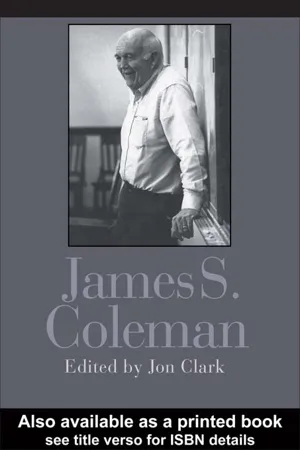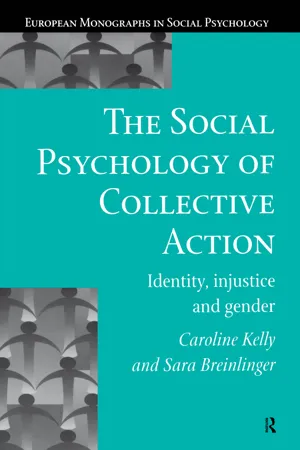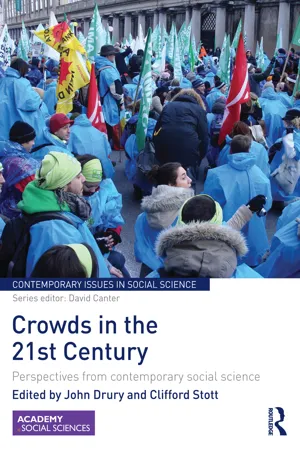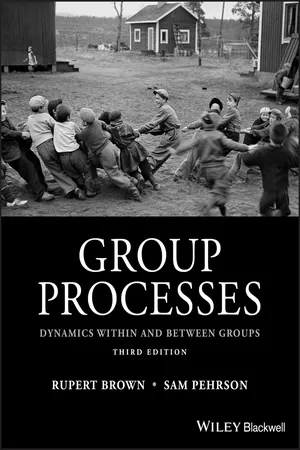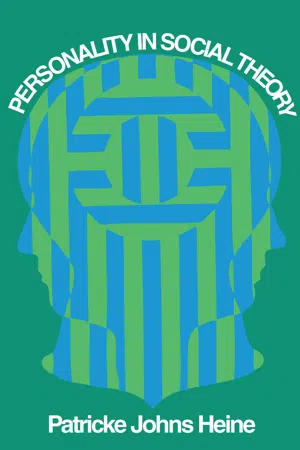Collective Behaviour
Collective behavior refers to the spontaneous and unstructured actions of a group of people in response to a particular situation. It involves behaviors such as riots, panics, and fads, which are often driven by emotions and lack clear leadership or organization. This phenomenon is studied to understand how individuals behave within a group and the factors that influence their actions.
8 Key excerpts on "Collective Behaviour"
- eBook - ePub
An Introduction to Social Psychology
Global Perspectives
- James Alcock, Stan Sadava(Authors)
- 2014(Publication Date)
- SAGE Publications Ltd(Publisher)
...Women in particular were front and centre in the Arab uprisings, emboldened by encouragement and coordination through social media to fight for social change (Radsch, 2012). What is Collective Behaviour? The examples above illustrate three defining characteristics of Collective Behaviour (Milgram & Toch, 1969). It is: A relatively rare phenomenon that emerges spontaneously in a collectivity of people (e.g., a crowd or an entire society). Unplanned and relatively unorganized, initially without a formal governance and without the specific rules and norms that characterize formal groups. Energized by inter-stimulation among the participants – that is, individuals are influenced by the actions of others, and their reactions in turn influence the very people who have affected them. Sometimes Collective Behaviour involves an intensification of anticipated reactions. For example, while teenagers may go to a rock concert expecting to be excited, interaction among audience members can create a collective experience that is much more powerful than anticipated and more intense than anything the individual would experience alone or in a small group. Inter-stimulation is reinforcing to some extent; otherwise the behaviour would quickly die out. If one person throws a rock through a window and is admonished by others, it is unlikely that this behaviour will spread. However, if some in the crowd cheer, then a second person may also break a window, and a third, and the behaviour may spread quickly throughout the throng. The study of Collective Behaviour is an important part of social psychology, not only in its own right, but also because there is hardly any aspect of social behaviour that does not occasionally find expression, sometimes even extreme expression, through some type of collective episode (Milgram & Toch, 1969). For example, prejudice is sometimes expressed through mob behaviour, which can involve aggression...
- eBook - ePub
- Kevin Wren(Author)
- 2013(Publication Date)
- Routledge(Publisher)
...4 Collective Behaviour Definitions Angry and peaceful crowds Two early theorists Rule-governed mob behaviour Deindividuation Social identity theory (SIT) Methodological problems Summary Definitions The term crowd behaviour, sometimes referred to as Collective Behaviour in other textbooks, needs to be defined. Surprisingly, in deciding what constitutes a human crowd, social scientists are fairly clear. Definitions vary, but there is a fair degree of similarity: Any relatively sizeable collection of people who are in direct interaction with one another in a public place. (Giddens, 1989) Behaviour of people en masse, such as in a crowd, protest or riot. (Hogg and Vaughan, 1995) A large but temporary gathering of people with a common interest or focus. (Reber, 1985) Behaviour in which large numbers of people who are in the same place at the same time behave in a uniform manner which is volatile, appears relatively unorganised, is characterised by strong emotion, and is often in violation of social norms. (Manstead and Hewstone, 1995) Along with the above, some social psychologists believe this area of study should include: semi-religious cult gatherings and social movements such as the Moonies; fads and fashions which occasionally sweep a nation such as the punk phenomena of the 1980s; political demonstrations and rallies; rumour transmission such as the lynch mobs of the southern states of the USA in the 1920s and 1930s; and panicking crowds such as at random shootings. An example of the extreme consequence of a human crowd out of control would be that of the Liverpool crowd at Sheffield Wednesday’s Hillsborough Stadium in 1989 when scores of fans were either killed or badly injured. But all large gatherings do not end in disaster. Angry and peaceful crowds Mann (1981) analysed newspaper reports of crowds present at attempted suicides. One such report was about a Puerto Rican man who attempted to jump from the tenth floor of a building...
- eBook - ePub
- Dr Jon Clark, Jon Clark, Dr Jon Clark, Jon Clark(Authors)
- 2005(Publication Date)
- Routledge(Publisher)
...11 Methodological Individualism and Collective Behaviour Benjamin Zablocki It’s amazing to me that the problem of accounting for Collective Behaviour has still not been solved. The phenomenon of elementary Collective Behaviour (riots, panics, expressive crowds, hostile mobs, fads, religious frenzies, etc.) has been kicking around the fringes of sociological theory for a long time. It has always seemed to be one of the potentially easier problems to solve even by the exacting and convoluted standards of the social sciences where every solution seems always to be up for rhetorical grabs. It looked like sociology was on the brink of fully explaining the phenomenon thirty years ago when Roger Brown (1965) threw a startling but brilliant light upon the subject by approaching it for the first time from an internally consistent perspective of rational action theory and methodological individualism. Brown’s approach, though necessarily sketchy, provided a theoretical framework within which a concerted program of research could be launched with the aim of solving the problem of Collective Behaviour. But then, as so often happens in our discipline, the problem was half solved and we lost interest in it and went on to other things. A review of James Coleman’s curriculum vitae shows that Coleman has been interested in the problem of Collective Behaviour from the very beginning of his career as a sociologist. Some of his very earliest publications (Coleman, 1957; Coleman and McPhee, 1958; Coleman, 1961c) represent early attempts to understand aspects of crowd behaviour and the closely related phenomenon of the diffusion of innovations. Although Collective Behaviour phenomena have never been at the forefront of Coleman’s research agenda, it is fair to say that the problem has been on his back burner consistently throughout the years...
- eBook - ePub
- Sara Breinlinger, Caroline Kelly(Authors)
- 2014(Publication Date)
- Taylor & Francis(Publisher)
...Chapter 2 Social Psychological Approaches to Collective Action DOI: 10.4324/9781315810133-2 Theoretical approaches to collective action are many and varied. Part of the reason for the heterogeneity derives from the different definitions of collective action which have been adopted. For many social scientists, the term collective action encompasses an incredibly broad range of empirical phenomena - 'from raising an army to raising a barn' (Marwell and Oliver, 1993 : 1) - whose common elements, these authors suggest, are mutual interests and the possibility of benefits from coordinated action. For those interested specifically in a political context, the term refers to a type of political action which consists principally of 'working through organised or informal groups... to raise an issue' (Parry, Moyser and Day, 1992 : 52). In the present research, we adopt a more social psychological definition of collective action: 'A group member engages in collective action anytime that he or she is acting as a representative of the group and the action is directed at improving the conditions of the entire group' (Wright, Taylor and Moghaddam, 1990 : 995). Even with this very specific definition, there are a number of different social psychological theories on which we can draw in trying to understand individual participation in collective action. The explanations which have been put forward to address the issue of individual participation may be divided into two types according to the level of analysis adopted. First, there are those explanations which focus on an individual level. These theories describe either individual personality characteristics or individual decision-making processes which lead particular people to get involved in action...
- eBook - ePub
Crowds and Public Order Policing
An Analysis of Crowds and Interpretations of Their Behaviour Based on Observational Studies in Turkey, England and Wales
- Ibrahim Cerrah(Author)
- 2018(Publication Date)
- Routledge(Publisher)
...It is for this reason that the definition and classification of crowds made many years ago, may no longer be accurate and may fail to embrace all the present crowd types. We need to reconsider the contemporary phenomenon of the crowd and re-assess it and its activities in an historical context. In line with this argument crowd theories themselves demonstrate a level of evolutionary development. For example, today’s theories on crowds differ greatly from the earlier ones, such as Le Bon (1898 and 1969), Sighele (1892) in Rule, (1988) and Tarde (1890) in Rule, (1988) in their approach to crowd movements as well as collective violence. Contrary to earlier studies, which tend to see crowds and collective action as primarily psychologically motivated, irrational and politically meaningless, modern studies stress the rationality and social importance of crowd actions even when they take a violent form. For some modern theorists, all forms of collective action are meaningful, rational and politically purposeful (Tilly, 1963 and 1970, in Rule, 1988). In this sense it is believed that it is more appropriate to regard crowd movements as ‘collective action’ rather than as ‘Collective Behaviour’. This implies that crowd movements are not the outcome of random psychologically determined human gatherings, but that perhaps they are more rational and politically purposeful than any individual action. Despite this shift in the academic arena from a psychological explanation of crowd events to an acceptance of a socially meaningful interpretation, the police response to crowd events has traditionally been on classic lines, based on an understanding of classical crowd theories with an expectation of violence or similar problems when they have to deal with certain crowds...
- eBook - ePub
Crowds in the 21st Century
Perspectives from contemporary social science
- John Drury, Clifford Stott, John Drury, Clifford Stott(Authors)
- 2015(Publication Date)
- Routledge(Publisher)
...According to this approach, individuals do not lose themselves in a crowd, but shift their self-categorisation from the individual (‘I’) to the group level (‘we’). Indeed, individuals who self-categorise as a group member (rather than as an individual) define and perceive themselves and their social world more in group (rather than individual) terms. As a consequence, their behavior is guided more by the group’s norms (rather than one’s personal norms), and one acts to achieve the group’s goals (rather than individual goals). In this analysis, group behavior is as rational as individual behavior, but the particular self-underlying and motivating behavior is different (Postmes & Spears, 1998; Reicher, 2001; Spears, 2010). With this recognition of the rationality of the group, it becomes possible to understand the crowd as a specific case of a psychological group in which in-group members are also physically co-present. Violence in crowds is therefore just one potential outcome of the collective action that individuals in crowds undertake, but solidarity and prosocial behavior are at least as likely (e.g. Drury et al., 2009). Based on these insights into the crowd, theory and research has moved in different ways. For instance, the Elaborated Social Identity Model (ESIM) of Drury, Stott, Reicher, and colleagues analyses the intergroup dynamics that govern crowd behavior (e.g. Drury & Reicher, 2009; Stott et al., 2001). These depend on, for example, the group norms that develop over time as a function of how a crowd and the police (or more generally the out-group) respond to each other. Rather than focusing on such intergroup dynamics, however, we focus on the intra-group process of whether individuals in a crowd can use the physical co-presence of in-group members as a psychological cue to in-group support. However, even when focusing on intra-group processes, important aspects of the inter-group situation remain important...
- eBook - ePub
Group Processes
Dynamics within and Between Groups
- Rupert Brown, Samuel Pehrson(Authors)
- 2019(Publication Date)
- Wiley-Blackwell(Publisher)
...Whilst presented as a general account of norm-violating impulsive behaviours that need not necessarily be antisocial, Zimbardo's emphasis on the destructive potential of group behaviour is clearly oriented towards explaining collective violence such as urban riots. The precedent can be found 70 years previously in the work of Gustave Le Bon (1896), whose popular text on the psychology of crowds was inspired by secondary accounts of various revolutionary crowds in nineteenth century France. For Le Bon, the behaviour of crowds is socially, morally, and intellectually inferior to that of individuals. The psychological transformation that he proposes to take place is very similar to those outlined in Zimbardo's model of deindividuation: crowds make people feel powerful and anonymous with a consequent loss of individual responsibility; crowd behaviour is fickle, irrational, and contagious, the loss of inhibition unleashing a collective unconscious that is inherently barbaric – ‘the animal within’ – and that spreads through the crowds as others mimic it uncritically. Both deindividuation theory and Le Bon's crowd psychology proceed from the same assumption that individuality is the sole basis for selfhood and that therefore we can only behave rationally as individuals (Reicher et al. 1995). Thinking and acting as part of a collective, in these accounts, is tantamount to a loss of self and so behaviour necessarily becomes meaningless and irrational. As we have seen, this understanding of self is at odds with a social identity perspective on group processes, in which personal uniqueness and commonality with group members are both potential bases for the definition of self, so Collective Behaviour is no less rational or meaningful than individual behaviour. In other words, what deindividuation theory regards as a loss of identity could alternatively be viewed as a shift from personal to social identity (Reicher et al...
- eBook - ePub
- Patricke Johns Heine(Author)
- 2017(Publication Date)
- Routledge(Publisher)
...In America, recent sociologies of collective behavior (such as Lang & Lang, 1961; Smelser, 1963) reflect a similar concern. These writers, too, analyze crowd phenomena in terms of specific programs and movements. They look for the reasons behind apparently unreasoned behavior, and they dismiss the “mysterious,” the “uncanny,” and the “psychopathic” explanations of old as no explanation at all. The dynamics of tension, excitability, and enthusiasm are “interaction processes” (they tell us) that can be related to specific social settings without reference to the mysteries of hypnotic or trance states, or unconscious or subliminal processes. Such a view is an academic one without obviously enjoying esteem or popularity in academic places. If anything, the old crowd psychology is reiterated with fresh fervor. Everyone knows there is a crowd psychology—a crowd mind, too. It is different from yours, and from mine, presumably, though all of us are in crowds every day. That difference requires drawing distinctions, and crowd analysts, over the years, have obliged by providing various classifications. But the taxonomy of crowds is a large and boring task while the underlying crowd psychology remains elementary and exciting. Usually its assumptions are taken for granted so that it matters little whether, like the author of Great American Riots (Headley, 1877), the description refers to: 1741 Negro Slave Riots or 1837 (“Starvation will always create a riot”) or 1863 (“Draft called a despotic measure”) or 1877 (the railroad riots that ushered in the labor movement) or to recent riots in Detroit, Chicago, Cleveland, or elsewhere. Nor does it seem to matter much whether the riot is a “race issue” or the “politics of youth” enacted on campus after campus as a new game called cops and students replaces, for front page news, the old one called cops and robbers. The likenesses of crowds, not their differences, are emphasized...


